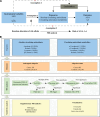Elucidating causal relationships of diet-derived circulating antioxidants and the risk of non-scarring alopecia: A Mendelian randomization study
- PMID: 38875426
- PMCID: PMC11175974
- DOI: 10.1097/MD.0000000000038426
Elucidating causal relationships of diet-derived circulating antioxidants and the risk of non-scarring alopecia: A Mendelian randomization study
Abstract
Previous observational studies revealed controversy about the effect of circulating antioxidants on risk of alopecia. In the present study, we investigated the causal relationships between diet-derived circulating antioxidants and 2 non-scarring alopecia using Mendelian randomization (MR). Instrumental variables for antioxidants (lycopene, retinol, ascorbate, β-carotene, α-tocopherol, and γ-tocopherol) were selected from published studies. Data for alopecia areata (AA) and androgenetic alopecia (AGA) was obtained from the FinnGen study project (R9 released in 2023), including 195 cases and 201,019 controls for AGA and 682 cases and 361,140 controls for AA. We used the inverse variance weighted method as the primary MR method. Three additional methods were used as sensitivity analysis to validate the robustness of the results. We found a causal relationship between absolute β-carotene levels and AGA risk (P = .039), but not with AA (P = .283). The results of Wald ratio showed a protective effect of absolute β-carotene levels against AGA, with per 0.1 ln-transformed β-carotene being associated with a 76% lower risk of AGA (OR: 0.24, 95% CI: 0.06-0.93). Based on the fixed effects inverse variance weighting results, we found that α-tocopherol was protective against both AGA (P = .026) and AA (P = .018). For each unit increase in α-tocopherol, the effects of change in AGA and AA were 0.02 (95% CI: 0.00-0.61) and 0.10 (95% CI: 0.01-0.67), respectively. The results did not reveal any other causal relationships. Our study identified 3 causal associations of antioxidants with the risk of non-scarring alopecia. These results provide new insights into the prevention of non-scarring alopecia through diet.
Copyright © 2024 the Author(s). Published by Wolters Kluwer Health, Inc.
Conflict of interest statement
The authors have no conflicts of interest to disclose.
Figures




Similar articles
-
Association between non-scarring alopecia and hypothyroidism: a bidirectional two-sample Mendelian randomization study.Front Endocrinol (Lausanne). 2024 Mar 18;15:1356832. doi: 10.3389/fendo.2024.1356832. eCollection 2024. Front Endocrinol (Lausanne). 2024. PMID: 38562416 Free PMC article.
-
Association between genetically predicted leukocyte telomere length and non-scarring alopecia: A two-sample Mendelian randomization study.Front Immunol. 2023 Jan 30;13:1072573. doi: 10.3389/fimmu.2022.1072573. eCollection 2022. Front Immunol. 2023. PMID: 36798520 Free PMC article.
-
Investigating Causal Associations of Diet-Derived Circulating Antioxidants with the Risk of Digestive System Cancers: A Mendelian Randomization Study.Nutrients. 2022 Aug 8;14(15):3237. doi: 10.3390/nu14153237. Nutrients. 2022. PMID: 35956413 Free PMC article.
-
Elucidating causal relationships of diet-derived circulating antioxidants and the risk of osteoporosis: A Mendelian randomization study.Front Genet. 2024 Jun 7;15:1346367. doi: 10.3389/fgene.2024.1346367. eCollection 2024. Front Genet. 2024. PMID: 38911297 Free PMC article.
-
Dietary Antioxidants, Circulating Antioxidant Concentrations, Total Antioxidant Capacity, and Risk of All-Cause Mortality: A Systematic Review and Dose-Response Meta-Analysis of Prospective Observational Studies.Adv Nutr. 2018 Nov 1;9(6):701-716. doi: 10.1093/advances/nmy040. Adv Nutr. 2018. PMID: 30239557 Free PMC article.
Cited by
-
Exploring the Association Between Multidimensional Dietary Patterns and Non-Scarring Hair Loss Using Mendelian Randomization.Nutrients. 2025 Aug 7;17(15):2569. doi: 10.3390/nu17152569. Nutrients. 2025. PMID: 40806153 Free PMC article.
References
-
- Kelly Y, Blanco A, Tosti A. Androgenetic alopecia: an update of treatment options. Drugs. 2016;76:1349–64. - PubMed
-
- Starace M, Orlando G, Alessandrini A, et al. . female androgenetic alopecia: an update on diagnosis and management. Am J Clin Dermatol. 2020;21:69–84. - PubMed
-
- Zhou C, Li X, Wang C, et al. . Alopecia areata: an update on etiopathogenesis, diagnosis, and management. Clin Rev Allergy Immunol. 2021;61:403–23. - PubMed
MeSH terms
Substances
LinkOut - more resources
Full Text Sources
Medical
Miscellaneous

